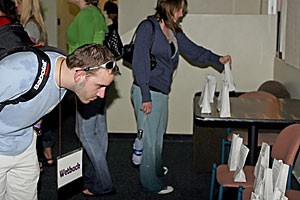As students walk into a dark, cramped room in the basement of Kaibab-Huachuca Residence Hall, the pleas of a young female begin to waft through the air. The lights flicker on as two young men scream “”faggot!”” into the face of a third.
This scenario is one of many that were displayed last night at the ninth annual Tunnel of Oppression, an event organized by Residence Life’s elMundo Diversity Initiatives to show students examples of injustices in society.
Rossivel Reid, a tour guide and geological engineering sophomore, said she thinks the event is amazing because it shows what it’s like to be oppressed.
“”It is very emotional and intense,”” Reid said. “”Last year I was with my girlfriend and the actors got to her really bad. We had to skip rooms.””
The tunnel first appeared in 1997, when it was developed at Western Illinois University with the purpose of being “”a way to bring the realities of oppression into a full sensory experiential manner,”” according to a Residence Life newsletter.
Loosely based on sections of the Museum of Tolerance in Los Angeles, “”the Tunnel of Oppression allows participants the opportunity to explore various forms of oppression and discrimination including racism, heterosexism, sexism, religious discrimination and privilege,”” according to the newsletter.
Students volunteer as actors in the event to portray these acts of oppression. In one room, for example, female and male participants act out true stories of abuse and rape in relationships.
Among other events was the “”privilege walk,”” where questions are posed to students in an effort to help them ponder their place in life, said Karen Morian, a tour guide and a senior majoring in French.
“”This is an activity where people can be put into perspective about their peer group,”” Morian said. “”We read off questions and have people reflect on their lives; they take physical steps away from each other to see how different they are.””
Courtney Wilson, an undeclared freshman, was one of more than a dozen students who attended the event as a requirement of a Tier One individuals and societies class.
“”I’m excited to see what it has. Our teacher just told us to come here,”” Wilson said. “”It’s required. She said to come to learn different things about life, society, discrimination, and gays and lesbians and sexuality.””
Toward the end of the tour, after experiencing several different types of hate first-hand, participants signed pieces of paper pasted to the walls of the Hall of Happiness, pledging to stop hate on campus.
The last segment of the tunnel was a question-and-answer segment with faculty members where students said how they felt after the experience.
“”It really showed me what it could be like to be oppressed,”” said Shain Bergan, a pre-journalism freshman. “”It is only one example, though. We really have no idea what it would be like in real life.””









